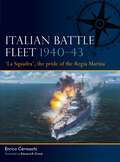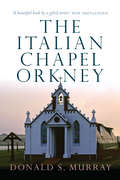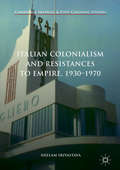- Table View
- List View
Italian Battle Fleet 1940–43: 'La Squadra', the pride of the Regia Marina (Fleet #6)
by Enrico CernuschiA comprehensive. illustrated account of the wartime Italian battle fleet, from its ships and technology to command structure, logistics, codebreaking and more.In the 1920s, the Italian Navy faced great challenges. Mussolini's ambitious Italy turned away from its alliance with Britain and France, and the Regia Marina faced the prospect of confronting both the French Navy and the Mediterranean Fleet of the Royal Navy. In the years leading up to World War II, the Regia Marina built and deployed a powerful battleship-led fleet – known in Italy as 'La Squadra' – intended to make the Mediterranean an Italian sea once more. In this book, Italian naval historian Enrico Cernuschi offers a fresh assessment of the wartime Italian battle fleet, based on his lifetime of primary-source research from both Italian and Allied sources. It offers a comprehensive portrait of this proud armada, how it was devised and built, and how it operated and fought. It covers a multitude of factors often overlooked, such as Italy's naval codebreakers, the fleet's logistics, and the qualities and limitations of Italian industry that supported it. The book also provides a concise account and analysis of the battle fleet's activities through the war, from major clashes such as the Battle of Calabria to lesser-known expeditions. The author's research into Italian wartime primary sources overturns some myths still commonplace in Anglo-American accounts. Illustrated with superb new artwork, maps and 3D diagrams, and featuring rare photos, this book is a fascinating account of Italy's great fleet of World War II.
Italian Battleships of World War II (New Vanguard)
by Paul Wright Mark StilleItaly's navy, the Regia Marina was the fourth-largest naval force in the world at the outbreak of World War II, and yet is often overlooked and largely discounted as ineffective. In general the fleet was made up of obsolete vessels, lacked radar functionality, and had a reputation for indiscipline and poorly trained crews. The complex and bureaucratic command system imposed on the fleet further hampered its effectiveness. In this book, Mark Stille details why the Italian battleships were able to maintain a solid reputation, examining their impressive designs and the courage and determination of the fleet at Calabria, Sirte, Cape Spartiveto and Cape Matapan, all illustrated with stunning photographs from the Italian Navy's own archives.
Italian Battleships of World War II (New Vanguard #182)
by Paul Wright Mark StilleItaly's navy, the Regia Marina was the fourth-largest naval force in the world at the outbreak of World War II, and yet is often overlooked and largely discounted as ineffective. In general the fleet was made up of obsolete vessels, lacked radar functionality, and had a reputation for indiscipline and poorly trained crews. The complex and bureaucratic command system imposed on the fleet further hampered its effectiveness. In this book, Mark Stille details why the Italian battleships were able to maintain a solid reputation, examining their impressive designs and the courage and determination of the fleet at Calabria, Sirte, Cape Spartiveto and Cape Matapan, all illustrated with stunning photographs from the Italian Navy's own archives.
Italian Blackshirt 1935–45 (Warrior)
by Pier Paolo Battistelli Giuseppe Rava Piero CrocianiThis book documents the experiences of the Italian armed Fascist militia, the Camicie Nere (Blackshirts), from the Italian–Ethiopian war of 1935–36, through the Spanish Civil War to the end of World War II. It explores their origins, development, recruitment, training, conditions of service, uniforms and equipment, battle experience, political and ideological motivation. The Blackshirt legions were raised under army control from 1928, and were employed in 1933 in Libya in counterinsurgency operations against the Senussi tribes; from 1935 in Italy's war against Ethiopia; and during the Spanish Civil War. Following the outbreak of World War II, the Blackshirts fought in North Africa, Greece, Croatia, on the Eastern Front and finally in Italy itself following the Allied invasion.
Italian Blackshirt 1935–45 (Warrior #144)
by Pier Paolo Battistelli Giuseppe Rava Piero CrocianiThis book documents the experiences of the Italian armed Fascist militia, the Camicie Nere (Blackshirts), from the Italian–Ethiopian war of 1935–36, through the Spanish Civil War to the end of World War II. It explores their origins, development, recruitment, training, conditions of service, uniforms and equipment, battle experience, political and ideological motivation. The Blackshirt legions were raised under army control from 1928, and were employed in 1933 in Libya in counterinsurgency operations against the Senussi tribes; from 1935 in Italy's war against Ethiopia; and during the Spanish Civil War. Following the outbreak of World War II, the Blackshirts fought in North Africa, Greece, Croatia, on the Eastern Front and finally in Italy itself following the Allied invasion.
The Italian Blitz 1940–43: Bomber Command’s war against Mussolini’s cities, docks and factories (Air Campaign)
by Richard WorrallBetween June 1940 and August 1943, RAF Bomber Command undertook a little-known strategic bombing campaign in Europe. The target was Mussolini's Italy. This air campaign was a key part of the strategic policy of Britain from 1940 to 1943, which aimed at securing Italy's early surrender. However, it posed unique challenges, not least of which was Italy's natural defences of distance and the Alps.The bombing campaign against Italy can be divided into a number of phases, with each one having its own specific goals such as affecting Italian war production or hindering the Italian Navy's war in the Mediterranean. However, each also furthered the ultimate aim of forcing Italy's final capitulation, demonstrating that the tactic of area-bombing was not just about the destruction of an enemy's cities, as it could also fulfil wider strategic and political objectives. Indeed, the intensity and frequency of attack was greatly controlled, and the heavy bombing of Italy was only ever sanctioned by Britain's civilian war leaders to achieve both military and political goals. The issue of target-selection was also subject to a similar political restriction; cities and ports like Milan, Turin, Genoa and La Spezia were sanctioned under an official Directive, but other places, such as Verona, Venice, Florence and, above all, Rome, remained off-limits. This fascinating title from British strategic and military history expert Dr Richard Worrall explores the political, motivational and strategic challenges of the campaign in full. His thorough analysis and meticulous research is supported by specially commissioned artwork, maps, and contemporary photographs.
The Italian Blitz 1940–43: Bomber Command’s war against Mussolini’s cities, docks and factories (Air Campaign #17)
by Richard WorrallBetween June 1940 and August 1943, RAF Bomber Command undertook a little-known strategic bombing campaign in Europe. The target was Mussolini's Italy. This air campaign was a key part of the strategic policy of Britain from 1940 to 1943, which aimed at securing Italy's early surrender. However, it posed unique challenges, not least of which was Italy's natural defences of distance and the Alps.The bombing campaign against Italy can be divided into a number of phases, with each one having its own specific goals such as affecting Italian war production or hindering the Italian Navy's war in the Mediterranean. However, each also furthered the ultimate aim of forcing Italy's final capitulation, demonstrating that the tactic of area-bombing was not just about the destruction of an enemy's cities, as it could also fulfil wider strategic and political objectives. Indeed, the intensity and frequency of attack was greatly controlled, and the heavy bombing of Italy was only ever sanctioned by Britain's civilian war leaders to achieve both military and political goals. The issue of target-selection was also subject to a similar political restriction; cities and ports like Milan, Turin, Genoa and La Spezia were sanctioned under an official Directive, but other places, such as Verona, Venice, Florence and, above all, Rome, remained off-limits. This fascinating title from British strategic and military history expert Dr Richard Worrall explores the political, motivational and strategic challenges of the campaign in full. His thorough analysis and meticulous research is supported by specially commissioned artwork, maps, and contemporary photographs.
The Italian Chapel Orkney: The Italian Chapel Orkney
by Donald S. MurrayShetland Times 'Above all, this book is about bringing colour, light and art to a dark northern island' – The ScotsmanThousands of visitors go to the Italian Chapel in Orkney every year, witnesses to a series of remarkable acts of transformation. Among these are the Churchill Barriers nearby, straddling the ocean to link a number of Orkney's southernmost islands to its mainland. Constructed to protect Britain's naval fleet in Scapa Flow during World War Two, its builders included a group of Italian soldiers imprisoned in this bleak and windswept part of Scotland. In the course of this, they not only played a part in changing Orkney's way-of-life forever but also transformed a simple Nissen Hut, constructing through their labours a place-of-worship that still stands till this day a remarkable symbol of their identity and faith. And On This Rock tells the story of the strength and tenacity, laughter and tears of the men who built the Italian Chapel, showing how spirits defeated and despondent during years of exile were lifted by its creation. It does this with its own artistry and grace, using folk-tale and myth to provide a fitting counterpart to the wonder and beauty of the building that inspired it.
Italian Colonial Troops 1882–1960 (Men-at-Arms)
by Gabriele EspositoA complete illustrated study of the varied range of Italian colonial units who served in East and North Africa.Italy only unified as a nation in 1870 and was late, and therefore impatient, in the 'scramble' for Africa. An initial foothold in Eritrea/Somalia, north-east Africa, led to a disastrous defeat in Ethiopia in 1896 at the Battle of Adwa, but Italian Somaliland was later consolidated on the west coast of the Red Sea. During 1911, Italy also invaded Libya, securing the coast, however fighting continued throughout World War I and only ended in the early 1930s. A number of native colonial regiments were raised in both Italian East Africa and Libya (in the latter, even a pioneering paratroop unit), of which most fought sturdily for Italy against the Allies in 1940–43. These units had particularly colourful uniforms and insignia. Another small guard unit also served in the Italian concession at Tientsin, China in 1902–1943. After World War II, a remnant unit served on in Somalia under a UN mandate until 1960.This intriguing volume describes and illustrates the dress and equipment used by these forces and details how they were deployed to maintain a colonial empire for over half a century.
Italian Colonial Troops 1882–1960 (Men-at-Arms)
by Gabriele EspositoA complete illustrated study of the varied range of Italian colonial units who served in East and North Africa.Italy only unified as a nation in 1870 and was late, and therefore impatient, in the 'scramble' for Africa. An initial foothold in Eritrea/Somalia, north-east Africa, led to a disastrous defeat in Ethiopia in 1896 at the Battle of Adwa, but Italian Somaliland was later consolidated on the west coast of the Red Sea. During 1911, Italy also invaded Libya, securing the coast, however fighting continued throughout World War I and only ended in the early 1930s. A number of native colonial regiments were raised in both Italian East Africa and Libya (in the latter, even a pioneering paratroop unit), of which most fought sturdily for Italy against the Allies in 1940–43. These units had particularly colourful uniforms and insignia. Another small guard unit also served in the Italian concession at Tientsin, China in 1902–1943. After World War II, a remnant unit served on in Somalia under a UN mandate until 1960.This intriguing volume describes and illustrates the dress and equipment used by these forces and details how they were deployed to maintain a colonial empire for over half a century.
Italian Colonialism and Resistances to Empire, 1930-1970 (Cambridge Imperial and Post-Colonial Studies)
by Neelam SrivastavaThis book provides an innovative cultural history of Italian colonialism and its impact on twentieth-century ideas of empire and anti-colonialism. In October 1935, Mussoliniʼs army attacked Ethiopia, defying the League of Nations and other European imperial powers. The book explores the widespread political and literary responses to the invasion, highlighting how Pan-Africanism drew its sustenance from opposition to Italy’s late empire-building, and reading the work of George Padmore, Claude McKay, and CLR James alongside the feminist and socialist anti-colonial campaigner Sylvia Pankhurst’s broadsheet, New Times and Ethiopia News. Extending into the postwar period, the book examines the fertile connections between anti-colonialism and anti-fascism in Italian literature and art, tracing the emergence of a “resistance aesthetics” in works such as The Battle of Algiers and Giovanni Pirelli’s harrowing books of testimony about Algeria’s war of independence, both inspired by Frantz Fanon. This book will interest readers passionate about postcolonial studies, the history of Italian imperialism, Pan-Africanism, print cultures, and Italian postwar culture.
Italian Cruisers of World War II (New Vanguard #258)
by Mark Stille Mr Paul WrightThe Italian Royal Navy (Regia Marina) operated one of largest cruiser forces of World War II. As a signatory to the 1922 Washington Naval Treaty, the Regia Marina immediately attempted to reinforce its treaty-limited battleship force by building seven large 10,000-ton heavy cruisers. Italian light cruisers also possessed an interesting design history and were involved in every major fleet engagement in the Mediterranean, as well as several smaller encounters with units of the British Royal Navy. Fully illustrated with specially commissioned artwork, this fascinating volume examines the history of the Regia Marina's cruisers during World War II where they came up against the might of the British Royal Navy.
Italian Cruisers of World War II (New Vanguard #258)
by Paul Wright Mark StilleThe Italian Royal Navy (Regia Marina) operated one of largest cruiser forces of World War II. As a signatory to the 1922 Washington Naval Treaty, the Regia Marina immediately attempted to reinforce its treaty-limited battleship force by building seven large 10,000-ton heavy cruisers. Italian light cruisers also possessed an interesting design history and were involved in every major fleet engagement in the Mediterranean, as well as several smaller encounters with units of the British Royal Navy. Fully illustrated with specially commissioned artwork, this fascinating volume examines the history of the Regia Marina's cruisers during World War II where they came up against the might of the British Royal Navy.
Italian Destroyers of World War II (New Vanguard)
by Mark StilleThe Italian Royal Navy (Regia Marine or RM) began the Second World War with one of the largest fleets in the world. Included in this was a total of 59 fleet destroyers, and others were added during the war. These were a diverse collection of ships dating back to the First World War, large destroyers built to counter ships of similar size being introduced in the French Navy (the RM's historical enemy), and medium-sized ships which constituted the bulk of the destroyer force. RM destroyers were built for high speed, not endurance since they were only expected to operate inside the Mediterranean. They were also well-armed, but lacked radar. During the war, RM destroyers fought well. With the exception of a small force based in Abyssinia which fought a series of battles in the Red Sea against the British, RM destroyers were active in the Mediterranean. The primary mission of the RM curing the war was to keep the supply lines to North Africa open. The Italians were largely successful in this effort, and destroyers were key in the effort. RM destroyers were present at every fleet action with the British Mediterranean Fleet.. The intensity of these actions were shown by the fact that the RM lost 51 destroyers during the war.
Italian Destroyers of World War II (New Vanguard #292)
by Mark StilleThe Italian Royal Navy (Regia Marine or RM) began the Second World War with one of the largest fleets in the world. Included in this was a total of 59 fleet destroyers, and others were added during the war. These were a diverse collection of ships dating back to the First World War, large destroyers built to counter ships of similar size being introduced in the French Navy (the RM's historical enemy), and medium-sized ships which constituted the bulk of the destroyer force. RM destroyers were built for high speed, not endurance since they were only expected to operate inside the Mediterranean. They were also well-armed, but lacked radar. During the war, RM destroyers fought well. With the exception of a small force based in Abyssinia which fought a series of battles in the Red Sea against the British, RM destroyers were active in the Mediterranean. The primary mission of the RM curing the war was to keep the supply lines to North Africa open. The Italians were largely successful in this effort, and destroyers were key in the effort. RM destroyers were present at every fleet action with the British Mediterranean Fleet.. The intensity of these actions were shown by the fact that the RM lost 51 destroyers during the war.
The Italian Empire and the Great War (The Greater War)
by Vanda WilcoxThe Italian Empire and the Great War brings an imperial and colonial perspective to the Italian experience of the First World War. Italy's decision for war in 1915 built directly on Italian imperial ambitions from the late nineteenth century onwards, and its conquest of Libya in 1911–12. The Italian empire was conceived both as a system of overseas colonies under Italian sovereignty, and as an informal global empire of emigrants; both were mobilized to support the war in 1915–18. The war was designed to bring about 'a greater Italy' both literally and metaphorically. In pursuit of global status, Italy fought a global war, sending troops to the Balkans, Russia, and the Middle East, though with limited results. Italy's newest colony, Libya, was also a theatre of the war effort, as the anti-colonial resistance there linked up with the Ottoman Empire, Germany, and Austria to undermine Italian rule. Italian race theories underpinned this expansionism: the book examines how Italian constructions of whiteness and racial superiority informed a colonial approach to military occupation in Europe as well as the conduct of its campaigns in Africa. After the war, Italy's failures at the Peace Conference meant that the 'mutilated victory' was an imperial as well as a national sentiment. Events in Paris are analysed alongside the military occupations in the Balkans and Asia Minor as well as efforts to resolve the conflicts in Libya, to assess the rhetoric and reality of Italian imperialism.
The Italian Empire and the Great War (The Greater War)
by Vanda WilcoxThe Italian Empire and the Great War brings an imperial and colonial perspective to the Italian experience of the First World War. Italy's decision for war in 1915 built directly on Italian imperial ambitions from the late nineteenth century onwards, and its conquest of Libya in 1911–12. The Italian empire was conceived both as a system of overseas colonies under Italian sovereignty, and as an informal global empire of emigrants; both were mobilized to support the war in 1915–18. The war was designed to bring about 'a greater Italy' both literally and metaphorically. In pursuit of global status, Italy fought a global war, sending troops to the Balkans, Russia, and the Middle East, though with limited results. Italy's newest colony, Libya, was also a theatre of the war effort, as the anti-colonial resistance there linked up with the Ottoman Empire, Germany, and Austria to undermine Italian rule. Italian race theories underpinned this expansionism: the book examines how Italian constructions of whiteness and racial superiority informed a colonial approach to military occupation in Europe as well as the conduct of its campaigns in Africa. After the war, Italy's failures at the Peace Conference meant that the 'mutilated victory' was an imperial as well as a national sentiment. Events in Paris are analysed alongside the military occupations in the Balkans and Asia Minor as well as efforts to resolve the conflicts in Libya, to assess the rhetoric and reality of Italian imperialism.
The Italian Executioners: The Genocide of the Jews of Italy
by Simon Levis Sullam David I. Kertzer Oona Smyth Claudia PataneA gripping revisionist history that shows how ordinary Italians played a central role in the genocide of Italian Jews during the Second World WarIn this gripping revisionist history of Italy’s role in the Holocaust, Simon Levis Sullam presents an unforgettable account of how ordinary Italians actively participated in the deportation of Italy’s Jews between 1943 and 1945, when Mussolini’s collaborationist republic was under German occupation. While most historians have long described Italians as relatively protective of Jews during this time, The Italian Executioners tells a very different story, recounting in vivid detail the shocking events of a period in which Italians set in motion almost half the arrests that sent their Jewish compatriots to Auschwitz.This brief, beautifully written narrative shines a harsh spotlight on those who turned on their Jewish fellow citizens. These collaborators ranged from petty informers to Fascist intellectuals—and their motives ran from greed to ideology. Drawing insights from Holocaust and genocide studies and combining a historian’s rigor with a novelist’s gift for scene-setting, Levis Sullam takes us into Italian cities large and small, from Florence and Venice to Brescia, showing how events played out in each. Re-creating betrayals and arrests, he draws indelible portraits of victims and perpetrators alike.Along the way, Levis Sullam dismantles the seductive popular myth of italiani brava gente—the “good Italians” who sheltered their Jewish compatriots from harm. The result is an essential correction to a widespread misconception of the Holocaust in Italy. In collaboration with the Nazis, and with different degrees and forms of involvement, the Italians were guilty of genocide.
The Italian Executioners: The Genocide of the Jews of Italy
by Simon Levis Sullam David I. Kertzer Oona Smyth Claudia PataneA gripping revisionist history that shows how ordinary Italians played a central role in the genocide of Italian Jews during the Second World WarIn this gripping revisionist history of Italy’s role in the Holocaust, Simon Levis Sullam presents an unforgettable account of how ordinary Italians actively participated in the deportation of Italy’s Jews between 1943 and 1945, when Mussolini’s collaborationist republic was under German occupation. While most historians have long described Italians as relatively protective of Jews during this time, The Italian Executioners tells a very different story, recounting in vivid detail the shocking events of a period in which Italians set in motion almost half the arrests that sent their Jewish compatriots to Auschwitz.This brief, beautifully written narrative shines a harsh spotlight on those who turned on their Jewish fellow citizens. These collaborators ranged from petty informers to Fascist intellectuals—and their motives ran from greed to ideology. Drawing insights from Holocaust and genocide studies and combining a historian’s rigor with a novelist’s gift for scene-setting, Levis Sullam takes us into Italian cities large and small, from Florence and Venice to Brescia, showing how events played out in each. Re-creating betrayals and arrests, he draws indelible portraits of victims and perpetrators alike.Along the way, Levis Sullam dismantles the seductive popular myth of italiani brava gente—the “good Italians” who sheltered their Jewish compatriots from harm. The result is an essential correction to a widespread misconception of the Holocaust in Italy. In collaboration with the Nazis, and with different degrees and forms of involvement, the Italians were guilty of genocide.
Italian Fascism in Rhodes and the Dodecanese Islands, 1922–44 (Routledge Studies in the Modern History of Italy)
by Aron Rodrigue Valerie McGuireThis book is the first English-language collection of scholarly essays to investigate the ambiguous and supporting role that colonialism in the Aegean Region played in Mussolini’s imperial ambitions, bringing to light a history rarely scrutinized until recently.The Dodecanese archipelago is often absent from histories of Italian fascist colonialism, as Italian territories in East Africa, Libya, and the Balkans have figured more centrally in discussions of how nationalism and later fascism relied on the empire to promote discourses of national renewal and regeneration. Over the past twenty years, a new wave of research has emerged, animated by the opening of previously closed state archives in various countries. This volume’s international contributors provide fresh perspectives on a topic frequently mythologized as a “golden period” of social and cultural intimacy among twentieth-century Greeks, Turks, and Jews. Themes include the fascist adaptation in the islands of Ottoman imperial governance, programs of infrastructure, development, and administration in the Dodecanese, Jewish history and memory in Rhodes, and the place of the islands in larger regional tensions of the interwar period. The volume will be of interest to scholars of Italian history, modern colonialism, fascism, Mediterranean studies, the end of the Ottoman Empire, and Sephardic Jewry.
Italian Fascism in Rhodes and the Dodecanese Islands, 1922–44 (Routledge Studies in the Modern History of Italy)
This book is the first English-language collection of scholarly essays to investigate the ambiguous and supporting role that colonialism in the Aegean Region played in Mussolini’s imperial ambitions, bringing to light a history rarely scrutinized until recently.The Dodecanese archipelago is often absent from histories of Italian fascist colonialism, as Italian territories in East Africa, Libya, and the Balkans have figured more centrally in discussions of how nationalism and later fascism relied on the empire to promote discourses of national renewal and regeneration. Over the past twenty years, a new wave of research has emerged, animated by the opening of previously closed state archives in various countries. This volume’s international contributors provide fresh perspectives on a topic frequently mythologized as a “golden period” of social and cultural intimacy among twentieth-century Greeks, Turks, and Jews. Themes include the fascist adaptation in the islands of Ottoman imperial governance, programs of infrastructure, development, and administration in the Dodecanese, Jewish history and memory in Rhodes, and the place of the islands in larger regional tensions of the interwar period. The volume will be of interest to scholars of Italian history, modern colonialism, fascism, Mediterranean studies, the end of the Ottoman Empire, and Sephardic Jewry.
The Italian Invasion of Abyssinia 1935–36 (Men-at-Arms)
by David Nicolle Raffaele RuggeriIn October 1935 Mussolini ordered the invasion of Ethiopia from Italian-held Eritrea and Somaliland, thinking that he would easily crush an ill-prepared and badly equipped enemy. The Italians, in the face of widespread condemnation from the League of Nations, spread terror and destruction through their indiscriminate use of air power and poison gas against an enemy more used to medieval methods of warfare. David Nicolle examines in detail the units, equipment and uniforms of the forces on both sides of this conflict that unrealistically bolstered Il Duce's colonial ambitions. A great read ably supported by Raffaele Ruggeri's detailed full-page colour plates.
The Italian Invasion of Abyssinia 1935–36 (Men-at-Arms)
by David Nicolle Raffaele RuggeriIn October 1935 Mussolini ordered the invasion of Ethiopia from Italian-held Eritrea and Somaliland, thinking that he would easily crush an ill-prepared and badly equipped enemy. The Italians, in the face of widespread condemnation from the League of Nations, spread terror and destruction through their indiscriminate use of air power and poison gas against an enemy more used to medieval methods of warfare. David Nicolle examines in detail the units, equipment and uniforms of the forces on both sides of this conflict that unrealistically bolstered Il Duce's colonial ambitions. A great read ably supported by Raffaele Ruggeri's detailed full-page colour plates.
Italian Jewish Musicians and Composers under Fascism: Let Our Music Be Played (Italian and Italian American Studies)
by Alessandro Carrieri Annalisa CapristoThis book is the first collection of multi-disciplinary research on the experience of Italian-Jewish musicians and composers in Fascist Italy. Drawing together seven diverse essays from both established and emerging scholars across a range of fields, this book examines multiple aspects of this neglected period of music history, including the marginalization and expulsion of Jewish musicians and composers from Italian theatres and conservatories after the 1938–39 Race Laws, and their subsequent exile and persecution. Using a variety of critical perspectives and innovative methodological approaches, these essays reconstruct and analyze the impact that the Italian Race Laws and Fascist Italy’s musical relations with Nazi Germany had on the lives and works of Italian Jewish composers from 1933 to 1945. These original contributions on relatively unresearched aspects of historical musicology offer new insight into the relationship between the Fascist regime and music.
Italian Light Tanks: 1919–45 (New Vanguard)
by Pier Paolo Battistelli Richard Chasemore Filippo CappellanoThe Italian army, unlike those of the British and French, did not use tanks in combat during World War I and, by November 1918, only one training unit equipped with French Schneider and Renault tanks had been formed. Consequently, during the 1920s the Italian army had just one single tank type in its armoured inventory – the Fiat 3000. Only in 1927 was the first tank unit formed as a branch of the infantry and not as an independent organization, while the cavalry rejected the idea of both tanks and armoured cars and decided to stand by the use of horses for its mounted units. Between 1933 and March 1939, a further 2,724 CV 33 / L 3 tanks were built, 1,216 of which were exported all over the world. By the time Italy entered the war in June 1940, the army had 1,284 light tanks, 855 of which were in combat units, including three armoured divisions. Variants of the CV 33 / L 3 tanks included flame-throwers, bridge-layers, recovery vehicles, and a radio command tank. Some L 3 tanks were still in use in 1945, by both the Germans and the German-allied Italian units of the Repubblica Sociale.



















